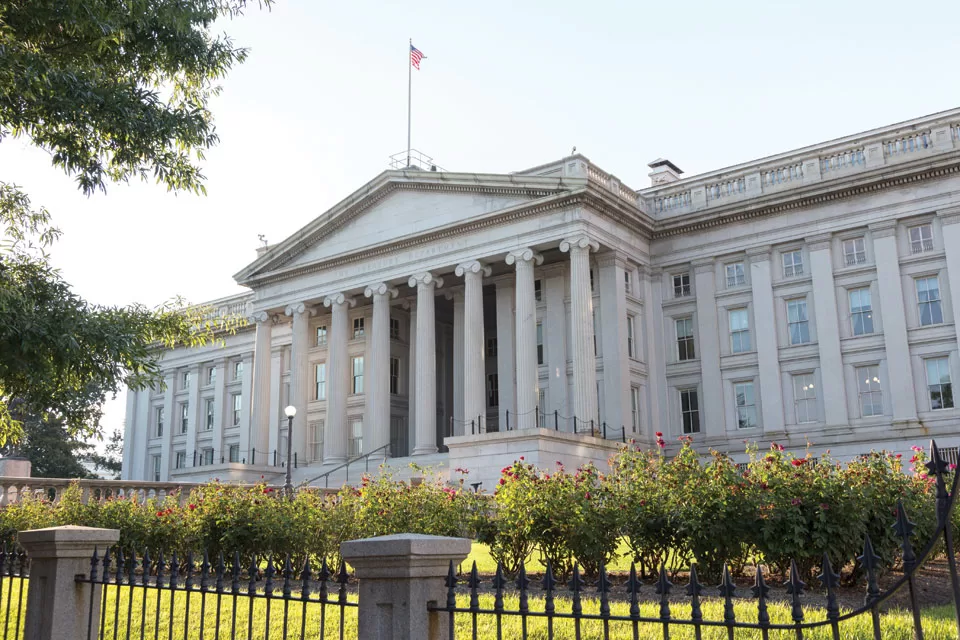
“Our national debt is approaching $1 trillion… If you had a stack of $1,000 bills in your hand only four inches high, you’d be a millionaire. A trillion dollars would be a stack of $1,000 bills sixty-seven miles high.”
– Ronald Reagan, 1981
Well, Reagan’s stack of $1,000 bills is now more than 2,400 miles high and growing, putting the top of the debt pile well beyond the reach of most manned spacecraft. And, paying off that stack of debt is most likely beyond the reach of the US government under its current policies.

How did we get here?
The story of the ballooning US national debt really begins in 1980. At the beginning of Reagan’s presidency, the debt-to-GDP ratio – the ratio of the national debt to the US gross domestic product – was 31%. Initially, there was hope that lower taxes under Reagan would generate faster GDP growth, which would keep debt to GDP at a low level, but this did not work. By the end of Reagan’s presidency, debt to GDP was just under 50%, a particularly large number at the time. In the ensuing decades, the ratio fluctuated within the 50% – 60% range until two major events – the global financial crisis of 2008 and the COVID pandemic of 2020 – led the federal government to take on massive levels of additional debt to stimulate the economy. At the end of 2024, the national debt stood at a sobering 120% of GDP, or $108,000 for every person in the country.
Are we at the tipping point?
The current debt level is alarming but not unprecedented. At the end of WWII, US debt to GDP reached 119%, but a combination of strong economic and productivity growth, tax reform, and spending controls enabled the country to rein in the national debt, reducing the debt-to-GDP ratio to below 50% in under 20 years. This suggests that if history is any indication, the problem is not insoluble.
As a modern-day comparison, Japan’s debt to GDP has been above 100% for over 20 years, and it currently sits above 250%. Despite this staggeringly high level of debt, Japan can still borrow at low interest rates while running a budget deficit of over 6% in 2024. So, the day of reckoning for the US is not necessarily imminent.
But where is the tipping point? No one knows how much debt is too much, and the extent of the bond market’s generosity is unpredictable. There is a limit, however, to how much debt the bond market is willing to absorb; if policymakers do not fix the problem, the bond market will eventually fix it for them.
There are numerous examples of investors (sometimes known as “bond market vigilantes”) imposing discipline on profligate governments. US bond prices sank, and yields skyrocketed, in the early 1980s in response to runaway inflation; investors shunned the bonds of Portugal, Ireland, Italy, Greece, and Spain in 2011 due to their unsustainable debts and deficits; and when UK Prime Minister Liz Truss’ government proposed increasing the deficit with massive unfunded tax cuts in 2022, UK bond markets were thrown into immediate crisis. During a period of bond market turmoil in 1994, political advisor James Carville quipped, “I used to think that if there was reincarnation, I wanted
to come back as the president or the pope or as a .400 baseball hitter. But now I would like to come back as the bond market. You can intimidate everybody.”

What can be done?
America’s debt addiction is a chronic condition, not an acute one. Despite the high levels of debt, at the end of 2024, real interest rates on US government bonds were less than half what they were in the 1980s when debt-to-GDP rose above 50%, and the dollar shows no signs of giving up its status as the world’s reserve currency. Luckily, the bond market has been forgiving – so far.
But the government’s lack of fiscal responsibility is not sustainable. On the current trajectory, estimates of debt-to-GDP in the early 2050s range from 155% to 192%. Even at those levels, the government would be unlikely to default on the debt; after all, the US Treasury can print dollars to pay off its bonds. But doing so would likely lead to higher inflation, higher interest rates, and a loss of confidence in the US dollar – a toxic combination that would harm the economy in the US and abroad.
The solution to the debt problem is simple in theory; we have had this level of debt before, and it was reduced significantly without a major crisis. But it may not be easy to implement. A significant economic expansion through higher productivity could allow us to grow our way out of debt, but absent that it will require a combination of higher taxes and lower government spending. In a healthy political environment, these are achievable goals, but given the vitriol in Washington, making progress toward them could be challenging, to say the least. A long-term solution will likely require personal sacrifices and the willingness of everyone to accept some policies that are not in their own best interest in the short term.
Another possible outcome is that the bond market forces the solution on us. If US debt levels approach the tipping point, interest rates will rise, the dollar will fall, the risk of recession will rise, and a furious electorate will demand immediate action.
Whether we address the problem proactively or the solution is forced upon us, the problem will eventually be solved, because it must be solved. A robust economy may provide a simple solution, but if it does not, breaking the country’s debt addiction will involve some difficult choices.
